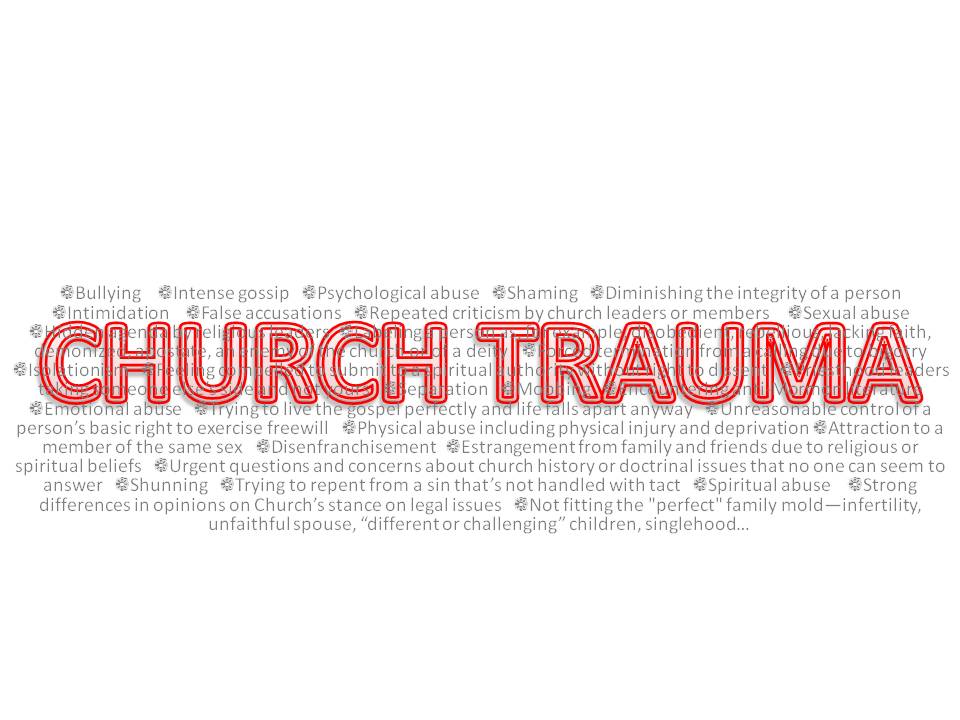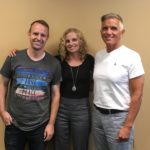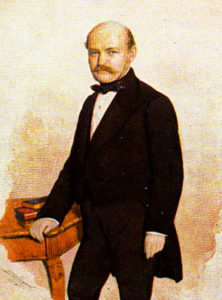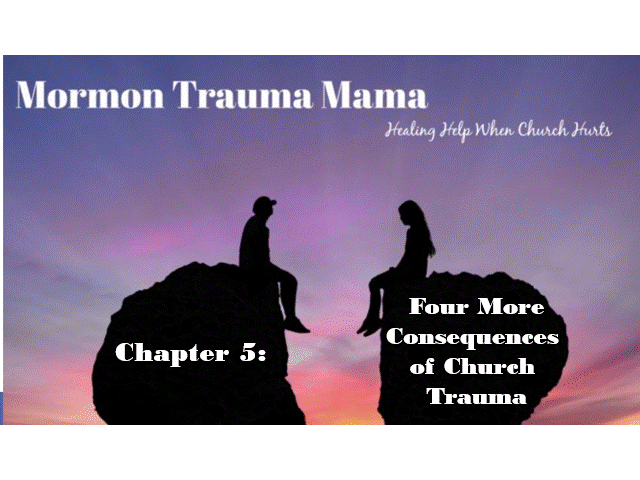
Church Trauma Is More Common than You Might Realize


Last month the Mormon Trauma Mama team hosted an invitation-only summit called When Church Hurts to talk about the problems we are seeing with church trauma and how we can promote awareness, healing, and change. We are still working on solutions to this problem—and will be for many years to come! But at the summit, I introduced a man who had a similar dilemma. Maybe you have heard about him. His name is Ignaz Semmelweis.
Semmelweis was a fascinating man. He was a European doctor, an obstetrician, in the mid-1800s. He worked at Vienna’s General Hospital, an important research hospital, where he tried to get to the bottom of a horrendous mortality rate among women in the maternity ward. In the section of the ward where Semmelweis practiced, the mortality rate was one in ten. Think of it. One in every ten women giving birth there died! Can you imagine?
Semmelweis gradually became obsessed with the problem. He was very troubled. He dug in to find the reasons. His inquiry eventually led him to think about the possible significance of research done on cadavers. 
Yes, cadavers. Remember, Vienna General was a research hospital. Many of the doctors split their time between research on cadavers and treatment of live patients. They didn’t see any problem with this practice because there was as yet no understanding of germs and bacteria.
But this gradually led him to develop a theory. He concluded that ‘particles’ were being transmitted to healthy patients on the hands of the physicians. So he immediately instituted a policy requiring physicians to wash their hands thoroughly in a chlorine and lime solution before examining any patient. And do you know what happened? The death rate immediately fell to one in a hundred!
So he was right: The doctors were the carriers. In fact, Semmelweis once sadly remarked, “Only God knows the number of patients who went prematurely to their graves because of me.” Imagine living with that. The doctors were doing the best they knew how, but they were carrying a disease they knew nothing about. It caused a multitude of debilitating symptoms, all of which could be prevented once the virus was identified.
As everyone in attendance at the summit recognized, there is a similar virus that is spread in the LDS Church—a virus that psychologically and spiritually kills members. The virus is church trauma. It is killing the worth, the faith, the trust, the ambition, and so much more of so many members. It’s destroying members who want or wanted to be a part of the LDS Church but cannot or could not find solid ground to stand on.
I have created a picture of what I think this virus looks like. Click here for an overview.
 But here’s what I want to address: Earlier this year, when I was really puzzling over this church-trauma virus and trying to figure out how to bring this problem home to common everyday Mormons, my friend Gerry Baird shared with me a blurb about how researchers helped domestic abuse victims recognize their own abuse. Historically, many domestic abuse victims thought what so many church members think: the problem is outside of them—others were perhaps victims but they weren’t. To help bring this home, researchers created formula stories—stories that were less extreme and recognizable. In this manner, they helped a great number of domestic abuse victim find the courage and recognition to say, “Me too.” In so doing, they helped thousands of victims find rescue, support, and healing.
But here’s what I want to address: Earlier this year, when I was really puzzling over this church-trauma virus and trying to figure out how to bring this problem home to common everyday Mormons, my friend Gerry Baird shared with me a blurb about how researchers helped domestic abuse victims recognize their own abuse. Historically, many domestic abuse victims thought what so many church members think: the problem is outside of them—others were perhaps victims but they weren’t. To help bring this home, researchers created formula stories—stories that were less extreme and recognizable. In this manner, they helped a great number of domestic abuse victim find the courage and recognition to say, “Me too.” In so doing, they helped thousands of victims find rescue, support, and healing.
I believe in many cases this is also what is needed for church-trauma victims to recognize their own abuse. The truth is, many members of the Church can likely identify with what is found in the branches of this illustration but most are not ready or able to see or examine the root causes of their distress and dysfunction.
Perhaps the reason it is particularly so is because the church system is all many members have ever known. Many have never been taught otherwise so the system seems normal and natural. It seems normal and natural to surrender to the commands and practices one has always been taught—to accept without question or examination, to willingly subject oneself to them. In this manner, a system of control is unconsciously adopted. Thus, for example, prophets will continue to tell members what to do and no one will question their wisdom and authority. Prophets maintain a position next to God, viewed as being fully incapable of leading members astray. Hence, members continue to give their power over to their leaders.
This likely seems harsh and even blasphemous to stalwart members of the Church. But the reality of this phenomenon really began to hold new meaning for me earlier this summer when I was invited to receive a mental analysis from a therapist. During the process, the therapist stopped and said, “Danna, there was a disconnect that happened to you in your mid twenties.” (When she said the word “disconnect,” my mind immediately went back to my first recognized brush with church trauma. My head had been hooked up to a computer and I was shown that I had undergone a trauma—a disconnect—in my brain.) But when this lady said this, I immediately refuted her, saying, “Oh no, that’s not so. I was doing so well in my twenties! I was living my dream. I knew I was doing what God had called me to do—I was teaching school and I loved every moment of it. It was my life mission and I was so happy to be using my God-given talents and enthusiasm to educate the rising generation!” But then I suddenly stopped and my eyes welled with tears and I said, “Oh wait. That’s when I realized I was pregnant and what that meant to me as good Mormon woman was that I had to give up my career and become a full-time, stay-at-home mom. I seriously didn’t think I could do it; I agonized over it for nine months. Could I really give up my life mission? I was so anguished over this. But when I met my beautiful daughter, OF COURSE I fell in love with her precious soul and because the choice was binary, I convinced myself that’s what I wanted to do.”
Now, don’t get me wrong; I’m not saying that this “disconnect,” this disempowerment, was all bad–good came from it as well–but what it did was it turned my power over to a different entity–the Church, which allowed the men in authority to decide when I taught, who I taught, what I taught, how long I taught. Thus, I looked solely to the Church to fulfill that need to teach. Now instead of looking to God to show me my mission, I looked to men to fill that void, with full faith that by following the prophet–who taught that women were to be in the home and who I believed spoke and acted for God–I would find my true path and God-given meaning for my life.
So when this surrendered-power approach soured four years later when I was serving as Young Women’s president and a bishop my age—who had his own motives and agenda—told me I was not serving and teaching up to his par, it explains why I suffered an all uppercase TRAUMA. (Please note that many details are not included here but recall that it was verified on a computer screen that the experience I endured did traumatize me and my life has never been the same since that night, so harmful and terrorizing was the experience and those that followed.)
Taking a jump back, let’s return to where we started: Ignaz Semmelweis. Semmelweis felt vindicated after the death rates dropped and women started to improve. He felt people surely would listen and hold merit to his claims. But even his dramatic results were not enough to change the minds of many doctors of his day and he died feeling very frustrated that the world would not hear him. That’s because the reality is, people are stubborn and change occurs slowly. It is hard to accept something that goes against what one has always been taught. Indeed, it can cause one great alarm and anguish to realize one’s cherished belief system has falsity and is potentially psychologically harmful. But the truth is, until we stop treating the symptoms—which is a mere band-aid approach—and start looking and addressing the roots of the problems found in the Church, this religion is not going to make a true and lasting mark on the health and wellbeing of its members. And that requires us to really examine and address the causal factors of trauma found in the LDS Church.
 **Danna is the founder and creator of The Mormon Trauma Mama. She is actively involved in advocating for those suffering from church trauma and is currently getting her Master’s degree in Pastoral Counseling from California Southern University. She has spoken at many events on the very real issue of church trauma in the LDS Church including the ADAM Conference and Sunstone Symposium and is being featured in the Hushed Ones Documentary. For more information on church trauma, find an overview on the MTM homepage which includes a presentation Danna did at the Joseph Smith Memorial Building.
**Danna is the founder and creator of The Mormon Trauma Mama. She is actively involved in advocating for those suffering from church trauma and is currently getting her Master’s degree in Pastoral Counseling from California Southern University. She has spoken at many events on the very real issue of church trauma in the LDS Church including the ADAM Conference and Sunstone Symposium and is being featured in the Hushed Ones Documentary. For more information on church trauma, find an overview on the MTM homepage which includes a presentation Danna did at the Joseph Smith Memorial Building.




5 Comments
Marel W
This is truly cutting edge. Very insightful and needed!
Jamy Webb
I really was intrigued by this. I particularly loved the story of Semmelweis. It is so hard for us to admit when we have made mistakes. We need to change this if we ever hope to heal as a church.
Your personal story was also very powerful. It has really helped me open my mind. Thank you.
Tim R.
Beautiful, powerful, bold, like a manifesto.
Yes, people are stubborn. We want to be right. We want to stay comfortable. We don’t want to examine.
Katherine Liener
This was very educational to me. You are hitting the core and it made me so sad as I recognized the truth of your words. Truly inspired work.
Nick Pratt
I really enjoyed this. You put into words what I have been trying to understand about myself and where and how I fit in the church. The anxiety and being uncomfortable around the people who express their love and friendship, while not accepting who you are shouldn’t be in the church.